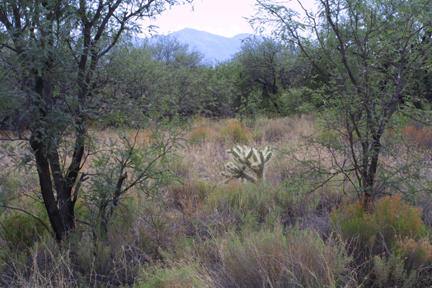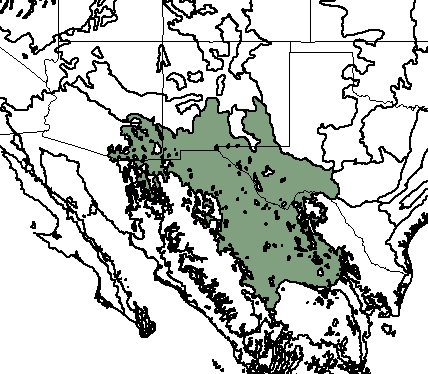
shrubland, southeastern Arizona
Bioimages home (click on an image to enlarge)
view
this page in its intended navigation context
Chihuahuan Desert
(WWF
ecoregion
NA1303)

shrubland, southeastern Arizona

Source of bioregions data:
Olson, D. M. and
E. Dinerstein. The Global 200: Priority ecoregions for global conservation. (PDF
file) Annals of the Missouri Botanical Garden 89:125-126.
Distinctiveness (1=highest,4=lowest): 1
(globally outstanding)
Measured by either species richness or endemism, this ecoregion may be the most
biologically diverse desert in the world. It contains over 250 species of
butterflies, 100 mammals, 250 birds, 100 reptiles, 20 amphibian, and 100 cacti.*
Conservation Status (1=most endangered, 5=most
intact): 3 (vulnerable)
This ecoregion is heavily degraded due to overgrazing, invasion by brush and
shrubby trees, and fire supression. This has resulted in conversion from
an area lush with native grasses and relatively free of shrubs to desert
shrubland. Threats also include urbanization, agricultural expansion, and
resource extraction.*

Larrea tridentata
(creasote bush) desert resulting
from overgrazing, north of Truth or Consequences, New Mexico (c) 2004
Maurice J. Kaufmann
hires
 Larrea tridentata
Larrea tridentata Prosopis velutina
(velvet mesquite)
Prosopis velutina
(velvet mesquite) Acacia
spp. (acacia)
Acacia
spp. (acacia)Associated habitats

monsoon rainstorm in August, Amado, Arizona
hires
* Ricketts, T.H., E. Dinerstein, D.M. Olson, C.J. Loucks, et al. (1999) Terrestrial Ecoregions of North America: A Conservation Assessment. World Wildlife Fund - United States and Canada. Island Press, Washington, D.C. pp. 341-344.
Except as noted, images copyright 2002-2004 Steve Baskauf - Terms of use